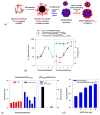Polymeric nucleic acid carriers: current issues and novel design approaches
- PMID: 22771981
- PMCID: PMC3502710
- DOI: 10.1016/j.jconrel.2012.06.036
Polymeric nucleic acid carriers: current issues and novel design approaches
Abstract
To deliver nucleic acids including plasmid DNA (pDNA) and short interfering RNA (siRNA), polymeric gene carriers equipped with various functionalities have been extensively investigated. The functionalities of these polymeric vectors have been designed to overcome various extracellular and intracellular hurdles that nucleic acids and their carriers encounter during their journey from injection site to intracellular target site. This review briefly introduces known extracellular and intracellular issues of nucleic acid delivery and their solution strategies. We examine significant yet overlooked factors affecting nucleic acid delivery (e.g., microenvironmental pH, polymer/siRNA complexation, and pharmaceutical formulation) and highlight our reported approaches to solve these problems.
Copyright © 2012 Elsevier B.V. All rights reserved.
Figures







Similar articles
-
Bioresponsive polymer-based nucleic acid carriers.Adv Genet. 2014;88:289-323. doi: 10.1016/B978-0-12-800148-6.00010-9. Adv Genet. 2014. PMID: 25409610 Review.
-
Co-delivery of small interfering RNA and plasmid DNA using a polymeric vector incorporating endosomolytic oligomeric sulfonamide.Biomaterials. 2011 Jul;32(21):4914-24. doi: 10.1016/j.biomaterials.2011.03.042. Epub 2011 Apr 12. Biomaterials. 2011. PMID: 21489622 Free PMC article.
-
Tuning Surface Charge and PEGylation of Biocompatible Polymers for Efficient Delivery of Nucleic Acid or Adenoviral Vector.Bioconjug Chem. 2015 Aug 19;26(8):1818-29. doi: 10.1021/acs.bioconjchem.5b00357. Epub 2015 Jul 23. Bioconjug Chem. 2015. PMID: 26158495
-
Enhancing the In Vitro and In Vivo Stabilities of Polymeric Nucleic Acid Delivery Nanosystems.Bioconjug Chem. 2019 Feb 20;30(2):325-337. doi: 10.1021/acs.bioconjchem.8b00749. Epub 2018 Dec 28. Bioconjug Chem. 2019. PMID: 30592619 Free PMC article. Review.
-
New amphiphilic carriers forming pH-sensitive nanoparticles for nucleic acid delivery.Langmuir. 2010 Sep 7;26(17):13874-82. doi: 10.1021/la1024185. Langmuir. 2010. PMID: 20672851
Cited by
-
Brief update on endocytosis of nanomedicines.Adv Drug Deliv Rev. 2019 Apr;144:90-111. doi: 10.1016/j.addr.2019.08.004. Epub 2019 Aug 13. Adv Drug Deliv Rev. 2019. PMID: 31419450 Free PMC article. Review.
-
Star-shaped tetraspermine enhances cellular uptake and cytotoxicity of T-oligo in prostate cancer cells.Pharm Res. 2015 Jan;32(1):196-210. doi: 10.1007/s11095-014-1455-7. Epub 2014 Aug 5. Pharm Res. 2015. PMID: 25092067
-
Bioreducible polymers as a determining factor for polyplex decomplexation rate and transfection.Biomacromolecules. 2013 Feb 11;14(2):548-56. doi: 10.1021/bm301794d. Epub 2013 Jan 7. Biomacromolecules. 2013. PMID: 23259985 Free PMC article.
-
pH-Triggered Sheddable Shielding System for Polycationic Gene Carriers.Polymers (Basel). 2016 Apr 14;8(4):141. doi: 10.3390/polym8040141. Polymers (Basel). 2016. PMID: 30979234 Free PMC article.
-
Controlling mesenchymal stem cell gene expression using polymer-mediated delivery of siRNA.Biomacromolecules. 2012 Nov 12;13(11):3841-9. doi: 10.1021/bm301294n. Epub 2012 Oct 11. Biomacromolecules. 2012. PMID: 23020123 Free PMC article.
References
-
- Glover DJ, Lipps HJ, Jans DA. Towards safe, non-viral therapeutic gene expression in humans. Nat Rev Genet. 2005 Apr;6(4):299–310. - PubMed
-
- Kim DH, Rossi JJ. Strategies for silencing human disease using RNA interference. Nat Rev Genetics. 2007;8:173–184. - PubMed
-
- Ferber D. Gene therapy: safer and virus-free? Science. 2001;294:1638–1642. - PubMed
-
- Watts JK, Deleavey GF, Damha MJ. Chemically modified siRNA: tools and applications. Drug Discov Today. 2008 Jul 7;13:842–855. - PubMed
Publication types
MeSH terms
Substances
Grants and funding
LinkOut - more resources
Full Text Sources

